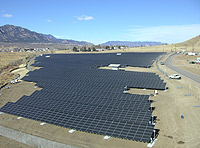Brown to Green: A New Use For Blighted Industrial Sites
 The Philadelphia
The PhiladelphiaNavy Yard sprawls over 1,200 acres on the banks of the Delaware
River, a once-great shipyard now being transformed into a mix of
research facilities, corporate offices, and manufacturing
plants.
In one remote, seven-acre corner - a nondescript plot of
land with a highway bridge towering above it - the Navy Yard’s
industrial past is palpable. Reeds and an occasional tree sprout
among dilapidated buildings of corrugated iron. Crumbling cinder
blocks are piled in a corner.
This forgotten corner of the city once served as a
landfill and incinerator for the Navy Yard. Shipbuilding and other
industrial activities, dating back to 1801, contaminated the site
with heavy metals, among other things. Since the Navy built its
last ship here in 1970, the area has sat largely unused.
But no longer: Soon these seven acres will be home to the largest
solar photovoltaic installation in Philadelphia. Construction is
scheduled to start this summer on the 1.3-megawatt, $5.6 million
Navy Yard solar array, with a target completion date of early
2012.
Every solar project that rises from an
industrial wasteland is one that won’t be built on pristine
land.
The facility will be capable of powering about 300 homes,
and will create 50 construction jobs and 10 permanent jobs,
according to developers.The Navy Yard solar array is just one of a
growing number of projects across the U.S. that fall into the small
category of energy ideas that appear to have little to no downside:
turning brownfields - or sites contaminated or disturbed by
previous industrial activity - into green energy
facilities.
Among the successfully completed brown-to-green projects
are a wind farm at the former Bethlehem Steel Mill in Lackawanna,
New York; a concentrating solar photovoltaic array on the tailings
pile of a former molybdenum mine in Questa, New Mexico; solar
panels powering the cleanup systems at the Lawrence Livermore
National Laboratory’s Superfund site in northern California; and
the U.S. Army’s largest solar array atop a former landfill in Fort
Carson, Colorado.
“It’s an untapped opportunity to not just deliver cleanup to
some of these contaminated or previously contaminated sites, but to
recycle our industrial legacy in making progress toward a cleaner
energy future,” said Chase Huntley, a policy advisor on energy and
climate change for the nonprofit Wilderness Society.
Communities from Philadelphia
to California are discovering, government support is critical to
enable solar and wind entrepreneurs to make use of these abandoned
lands.Huntley’s group is interested in
preserving the country’s remaining wild lands, and every solar or
wind project that rises from an industrial wasteland is one that
won’t be built on a pristine ridgeline or tract of desert. Another
plus is that public opposition to renewable energy projects on
blighted land is highly unlikely.
Though practical considerations abound, the potential involved in
taking contaminated land and putting it to use as solar or wind
farms is enormous. The U.S. Environmental Protection Agency (EPA)
estimates that more than 490,000 brownfields exist nationwide,
largely concentrated in formerly industrialized regions.
target=”_blank”>Read more
Source: e360.yale.edu

